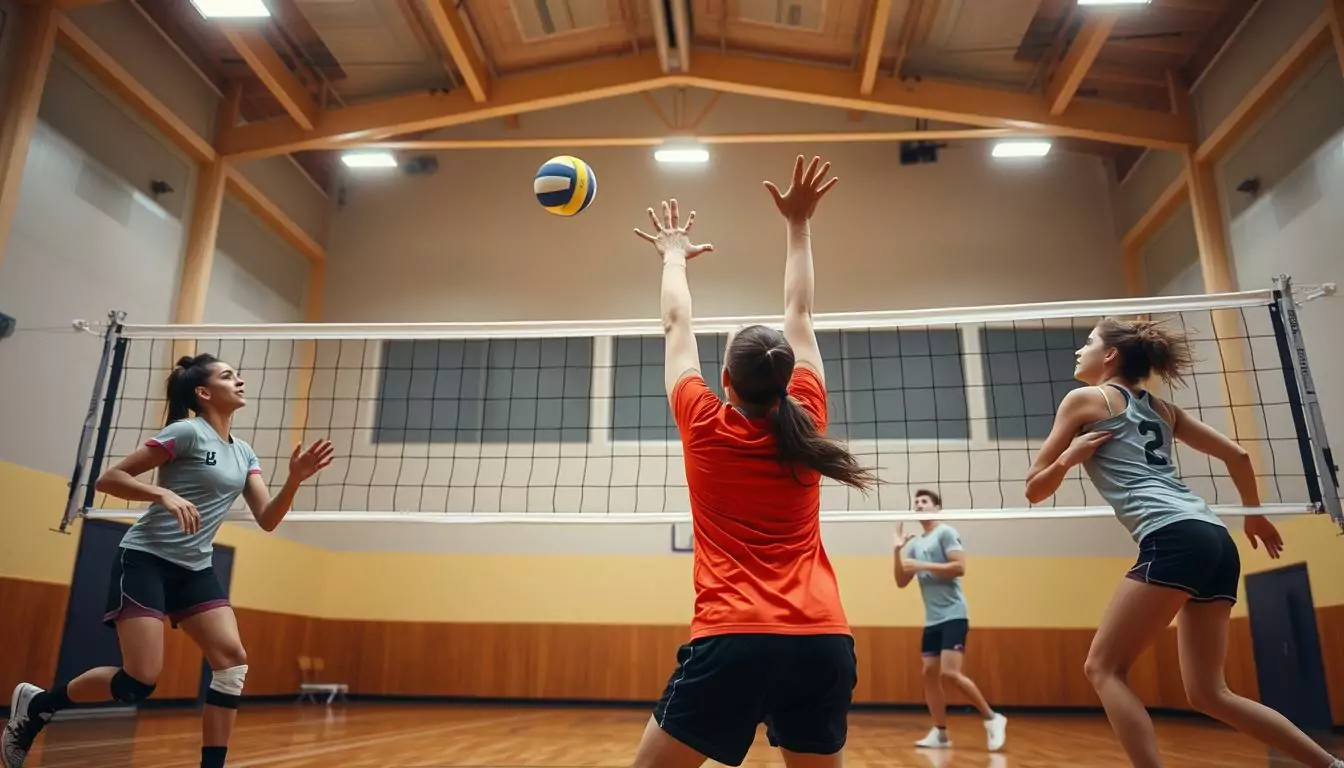Did you know a standard volleyball match can last up to five sets? Each set is played to 25 points. This sport is loved by players of all levels, from casual fans to top athletes. Knowing the basic rules of volleyball is key to enjoying this exciting game.
In this detailed guide, we’ll explore the essential rules of volleyball. You’ll learn about the gameplay, scoring, and regulations that make this sport unique. Whether you’re an experienced player or new to the game, this guide will help you dive into the world of volleyball.
Key Takeaways
- Volleyball matches usually have 3 or 5 sets, with each set to 25 points (or 15 in the fifth set).
- Teams have 6 players on the court, with 3 in the front and 3 in the back.
- Points are scored on every serve, and a ball hitting a boundary line is in-bounds.
- Players can’t hit the ball twice in a row or catch, hold, or throw it.
- Some rule violations, like touching the net or attacking a serve from within 10 feet, give points to the opponent.
Introduction to Volleyball Rules
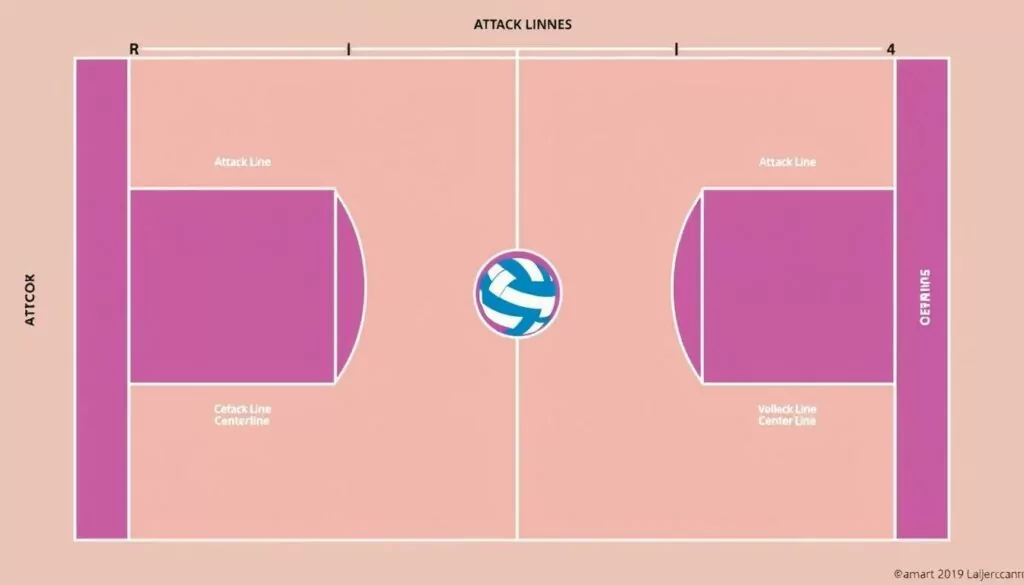
Volleyball is a fast-paced sport that needs quick reflexes and teamwork. It involves six key skills: serving, passing, setting, attacking, blocking, and digging. Knowing these skills and the rules is key for players to play well and avoid mistakes.
What Makes Volleyball Unique?
Volleyball is special because of its fast pace and teamwork. The ball moves quickly, requiring players to react fast and make quick decisions. The game also emphasizes teamwork, making it a sport that values communication and cooperation.
Importance of Understanding the Rules
Knowing the rules of volleyball is vital for players and fans. The game has changed a lot, but its core rules remain the same. This knowledge helps players play fairly and execute strategies well. For fans, it makes the game more enjoyable and interesting.
The volleyball court size is 18m (59ft) long and 9m (29.5ft) wide. The top of the net is 2.43m (7.97ft) high for men and 2.24m (7.35ft) for women. A volleyball weighs 260-290gms (9.2-9.9 ounces) and is 65-67cm (25.5-26.5 inches) in circumference.
| Volleyball Terminology | Description |
|---|---|
| Rally Scoring | A scoring system where points are awarded on every rally, regardless of which team served. |
| Libero | A specialized defensive player who is restricted to the back row and cannot block or attack from in front of the attack line. |
| Spike | The most commonly used offensive move, involving a powerful downward hit of the ball into the opposition’s court. |
The Basic Objective of the Game
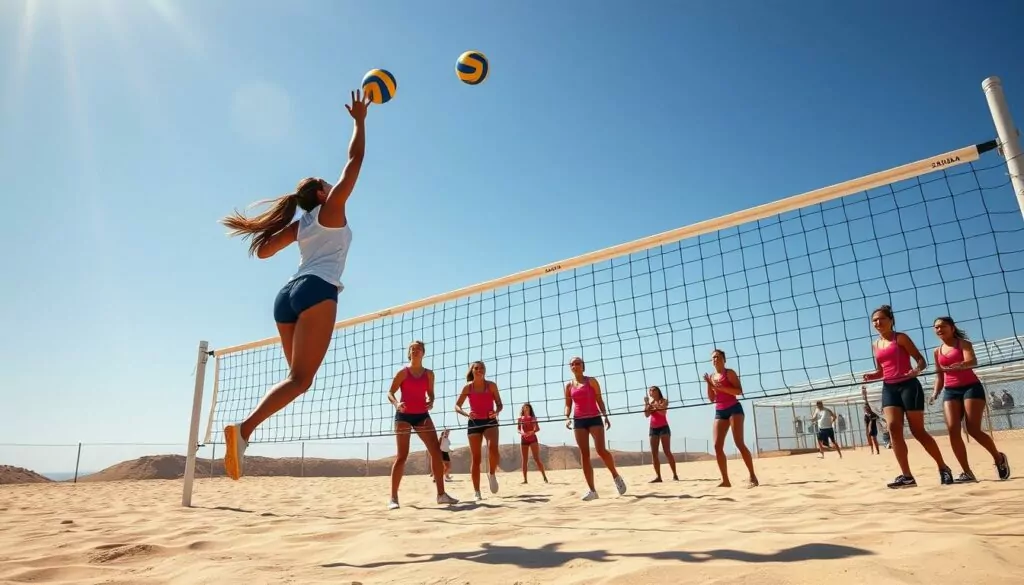
Volleyball is a dynamic and captivating sport loved by players and fans around the world. The main goal is to score points by making the ball land on the opponent’s court. The game has complex rules and strategies that make it unique and engaging.
Scoring System Explained
A volleyball match is played in a best-of-five sets format. The first four sets are won at 25 points, and the fifth set at 15 points if needed. A team must be two points ahead to win a set. This scoring system makes the game fast and exciting.
Winning a Match
The team that wins three sets first wins the match. This format, known as the volleyball match format, ensures a fair competition. The volleyball scoring system rewards consistent and well-executed play, making every point important.
“Volleyball is a game of strategy, teamwork, and precision. The scoring system and match format are designed to highlight these fundamental aspects of the sport.”
Knowing the basic objective, volleyball scoring system, and volleyball match format helps players and fans enjoy the sport’s nuances and excitement.
Volleyball Court Dimensions
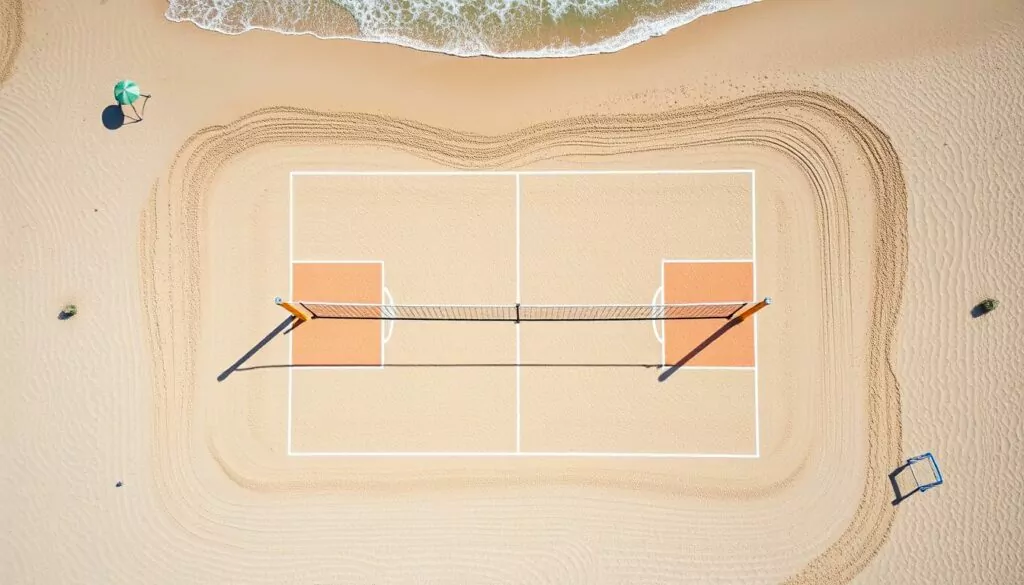
Knowing the size of a volleyball court is key for players and fans. An indoor court is 18m (59ft) long and 9m (29.5ft) wide. It’s split into two halves by a net. The volleyball court size can change a bit based on the game level or competition rules. But these sizes are the most common.
Size and Layout
The court has an attack line 3m (10ft) from the net on each side. This line divides the court into front and back zones. Players have different roles in these areas. The service zone, a 9m (29.5ft) wide area behind the end line, is also key.
The net is very important, standing at 2.43m (7.97ft) for men and 2.24m (7.35ft) for women. This volleyball net height is set to ensure fair play at all levels.
There are different court sizes for beach volleyball and youth games. Beach volleyball courts are 16m (52.5ft) long and 8m (26.25ft) wide. Youth courts can be 12.8m to 15.2m (42ft to 50ft) long and 6.1m to 7.6m (20ft to 25ft) wide.
Despite the different sizes, the court layout and net height aim to make the game fun and challenging for all players.
Team Composition in Volleyball
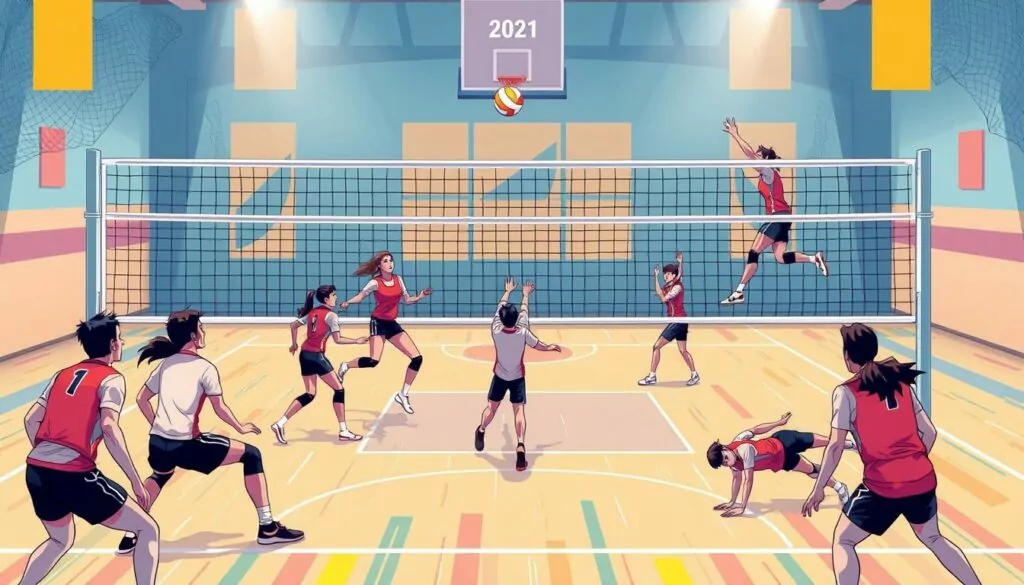
Volleyball is a dynamic team sport that needs a well-balanced team to win. At the heart of any successful team is the mix of players, each with a unique role. Knowing the different positions and their roles is key for both players and fans.
Number of Players
A standard volleyball team has up to 8 players, with 6 on the court at a time. This includes three female players always on the court. Teams not following these rules will lose the game.
Positions and Roles
- Setter: The team’s quarterback, who passes the ball to the hitters.
- Middle Blocker: At the net’s center, they block the other team’s attacks.
- Outside Hitter: The main offense, attacking from the left side.
- Opposite Hitter: Also known as the “right-side hitter,” they attack from the right side.
- Libero: A defensive expert, wearing a different jersey and can substitute freely.
Each position is vital for the team’s strategy and success. By knowing the volleyball player positions and volleyball team composition, teams can plan better and perform better.
Starting and Restarting the Game

In volleyball, the game starts with a serve from behind the end line. Players then rotate clockwise after winning the serve. This lets each team member serve, promoting fair play and strategic court positioning.
The Serve: How It Works
The serve is key in volleyball. Players must follow rules when serving the ball. The server must stand behind the end line and hit the ball with their hand, making it cross over the net to the opposing team’s side. Good serving technique is vital for a strong start to the rally.
Rotation and Substitution Rules
Volleyball players must keep a consistent serving order. But, they can move to their playing positions after the serve. Substitutions are limited, with a max of 12 per set in some rules and 6 in international play. These rules keep the game flowing and ensure all players get a chance to play.
Understanding the serve, rotation, and substitution rules is key for volleyball players. These basics are essential for a good game start and restart. They help make volleyball a strategic and fair sport.
| Volleyball Rotation and Substitution Rules | Details |
|---|---|
| Maximum Substitutions per Set | 12 (domestic rules), 6 (international) |
| Time-out Duration | 30 seconds |
| Maximum Timeouts per Set | 2 per team |
| Injured Player Recovery Time | 3 minutes (maximum once per player per match) |
| Expelled or Disqualified Player Substitution | Must be substituted through a legal substitution |
| Illegal Substitution Penalty | Delay sanction (recorded on the scoresheet) |
By following the volleyball serve rules and volleyball rotation guidelines, players can ensure a smooth game start and restart. This makes volleyball more enjoyable and fair for everyone.
Scoring in Volleyball

Volleyball is a dynamic sport with a scoring system that keeps everyone on the edge of their seats. At its core is rally scoring. This means a point is awarded on every serve, no matter who served the ball.
Rally Scoring Explained
In rally scoring, the team that wins a rally gets a point. This is true even if they weren’t the serving team. This fast-paced system makes every point important, adding excitement and tension to the game. The team that reaches 25 points first, with a two-point lead, wins the set.
Points and Sets
- Volleyball matches are usually played in a best-of-five-sets format. The first team to win three sets is declared the winner.
- Each set is played to 25 points, except for the fifth set. The fifth set is played to 15 points.
- If the score is 24-24 in a set, play continues. It keeps going until one team leads by two points to win the set.
- In the fifth set, the first team to reach 15 points and lead by two points wins the set and the match.
The mix of rally scoring and the best-of-five-sets format makes volleyball intense and dynamic. Every point is key, and the outcome is uncertain until the final whistle.
“Volleyball is a game of momentum, and rally scoring amplifies that. Every point matters, which makes the game incredibly exciting to play and watch.”
– John Doe, Volleyball Coach
Fouls and Violations
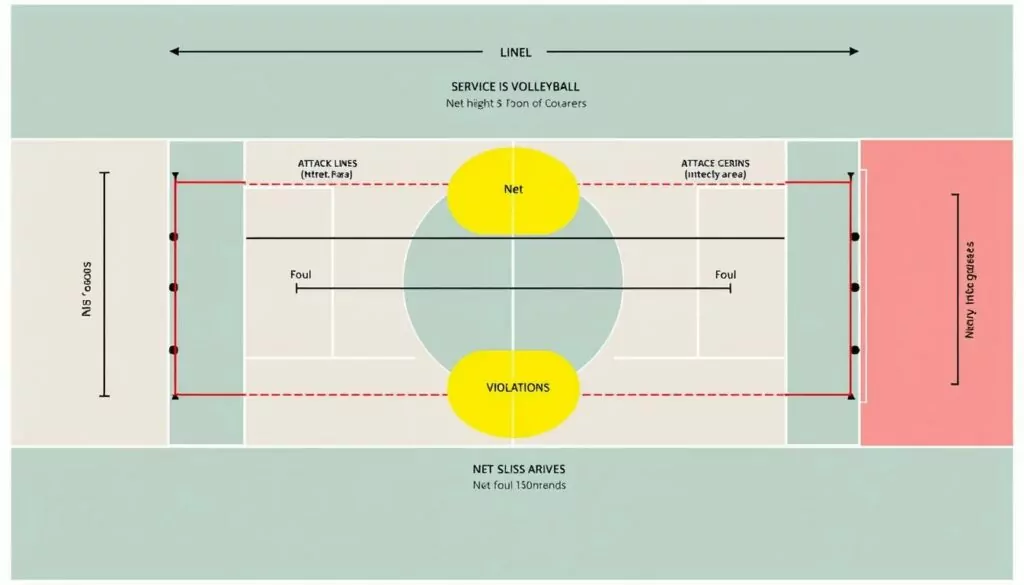
Volleyball is a fast-paced sport that requires skill, strategy, and rule-following. Knowing the common infractions and their effects is key for players and fans. Any rule-breaking can change the game’s flow and outcome.
Common Infractions
Here are some common volleyball fouls and violations:
- Touching the net: Players can’t touch the net during play, which can hinder the opposing team.
- Stepping over the service line: The server must stay behind the service line until the ball is hit.
- Double hitting: Players can only hit the ball three times before it must be returned over the net.
- Hitting the ball out of bounds: If the ball goes outside the court, it’s out of bounds.
The Consequences of Violations
Violations can have big consequences. If a team commits a foul, the other team gets a point. The serving team also loses their turn. Serious infractions, like unsportsmanlike conduct, can lead to penalties or even being kicked out of the game.
| Violation Type | Percentage of Occurrence | Impact on the Game |
|---|---|---|
| Hitting the ball 4 times before returning it | 12% | Leads to a point being awarded to the opposing team and a loss of serve |
| Assisted hit violations | 18% | Results in a fault and point for the opposing team |
| Foot faults during service | 8% | Causes a side-out and loss of serve for the violating team |
By following the rules, players can ensure a fair game for everyone. It’s important to avoid common volleyball fouls and volleyball violations to keep the sport’s integrity.
The Role of the Referee
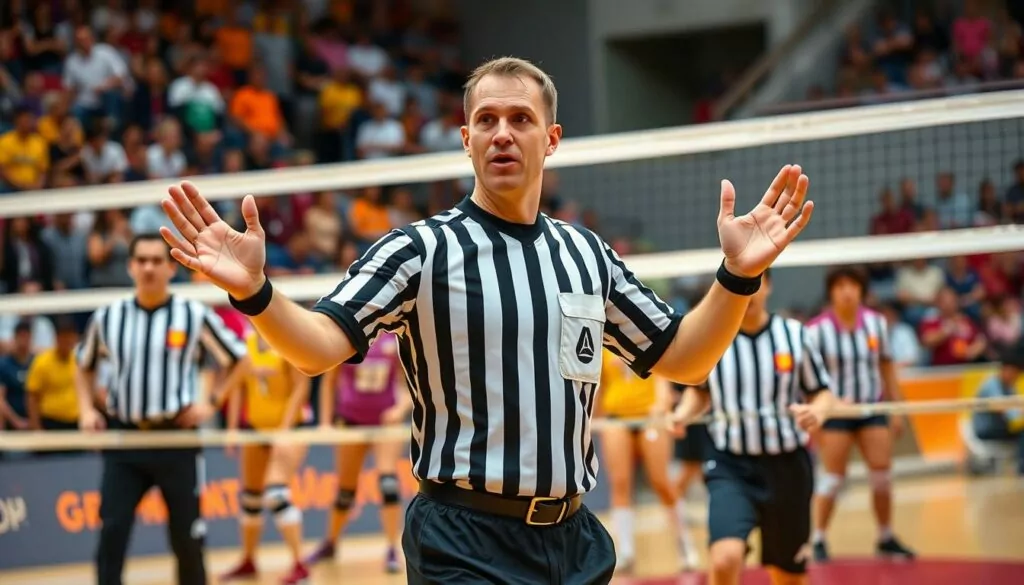
In volleyball, the referee is key to a fair and smooth game. They enforce rules, call out violations, and manage the game. Using hand signals, they clearly tell players, coaches, and fans what’s happening.
Responsibilities of the Referee
The main jobs of a volleyball referee are:
- Checking the playing area, equipment, and ball before the game starts.
- Watching the teams’ positions and rotations to make sure they follow the rules.
- Spotting and calling out violations like net faults, out-of-bounds hits, and illegal serves.
- Deciding which team made the mistake and giving points to the other team.
- Allowing and managing timeouts, substitutions, and other breaks in play.
- Keeping the game in order, dealing with bad sportsmanship, and giving penalties if needed.
- Confirming the final score and signing the official scoresheet after the game.
Signals Used During the Game
Referees use hand signals to tell everyone about their calls. These signals show who made the mistake and what happens next. It’s important for players and fans to know these signals to follow the game.
| Signal | Description |
|---|---|
| The referee holds up one arm straight up with the palm facing forward. This means a fault or violation, like a net touch or lift. | |
| Both arms go straight up with palms facing each other. This signals a point or side-out, giving the serving team a point or a turn to serve. | |
| One arm goes out horizontally with the palm down, pointing to the next serving team. This tells who gets to serve the ball. |
The Serve: Techniques and Rules
In volleyball, the serve is key to starting every point. Players must stand behind the end line and hit the ball before stepping over it. This ensures a fair start to the rally.
If the served ball hits the net and goes over to the opponent’s court, it’s playable. But if it doesn’t, the opposing team gets a point.
Underhand vs. Overhand Serve
Volleyball players can choose between two main serve techniques: underhand and overhand. The underhand serve is great for beginners because it offers better control. It lets players aim more precisely at the court.
The overhand serve, on the other hand, is faster and more powerful. But it’s harder to control, making it a challenge for opponents.
Service Errors
Players must avoid service errors to play well. Common mistakes include hitting the ball too early, touching the end line before hitting the ball, and serving out of turn. These errors give points to the opposing team.
So, mastering serving techniques and following the rules is key. It helps your team win more games.
“The serve is the most important shot in volleyball, as it’s the only time you have complete control over the ball.” – Mick Haley, former U.S. Olympic volleyball coach
Whether you prefer the underhand or overhand serve, knowing the rules and techniques is vital. By improving your serving and avoiding mistakes, you can help your team win more games.
Passing in Volleyball
Volleyball is a fast-paced game that needs precise ball control and distribution. Passing is a key skill that sets up a team’s offense. We’ll look at the different types of passes and why proper techniques are important.
Types of Passes
There are two main types of passes in volleyball: the forearm pass and the overhead pass.
- The forearm pass is the most basic and often used pass. It uses the forearms to control and direct the ball to the setter or teammates.
- The overhead pass, or set, is for higher balls. It needs good hand-eye coordination and timing. This pass is used to set up an attack or to move the ball to the front row.
Legal and Illegal Passes
Understanding the rules of legal and illegal passes is key in volleyball. A legal pass involves brief contact with the ball, without visible hand or arm rest. Illegal passes include catching, throwing, or double-hitting the ball.
The first touch after a serve or attack is often a pass. This initial pass is vital for setting up the team’s offense and keeping ball control.
| Legal Passes | Illegal Passes |
|---|---|
| Forearm pass (bump) | Catching the ball |
| Overhead pass (set) | Throwing the ball |
| Brief contact with the ball | Double-hitting the ball |
Developing strong volleyball passing techniques and ball handling skills is key for all players. Mastering passing helps teams move from defense to offense and opens up scoring chances.
“The first pass is the most important play in volleyball. It sets the tone for the entire rally and can make or break a team’s offense.”
Hitting and Attacking Rules
In volleyball, hitting and attacking the ball is key. Knowing different hits and attack line rules can help players a lot.
Types of Hits
Volleyball has many attacking techniques. Each has its own purpose and way of doing things. Here are some common ones:
- Spikes: A strong, overhead hit that sends the ball fast over the net. It often scores a point for the team hitting.
- Tips: A soft touch over the net. It’s used to find gaps in the defense.
- Roll shots: A soft, slow hit that rolls over the net. It surprises the defense.
Attack Line Rules
The attack line is important in volleyball. It tells players where they can hit the ball. Here are the main rules:
- Back-row players must jump from behind the attack line to hit the ball high.
- Front-row players can hit the ball from anywhere on their side of the net.
- Players can’t hit the opponent’s serve high if they’re in front of the attack line.
Knowing these rules and mastering hitting techniques is vital. It helps players and teams do better in the game. By using these skills, players can attack more effectively and get ahead.
| Volleyball Attacking Statistics | Average Value |
|---|---|
| Attack Percentage | 0.300 |
| Kills per Set | 12.5 |
| Hitting Errors per Set | 4.8 |
| Attempts per Set | 37.2 |
“The most effective volleyball attacks come from a combination of power, precision, and tactical awareness.”
Blocking in Volleyball
Blocking is a key defensive skill in volleyball. It lets players stop the other team’s attacks. Knowing the rules and techniques of blocking is vital for any player.
How Blocking Works
Only front-row players can block the ball in volleyball. They jump and reach over the net to deflect attacks. A block touch doesn’t count as a hit, giving the team more chances to return the ball.
- Players can block by reaching across the net, but they can’t interfere with the opponent’s play before the attack.
- Liberos, the defensive specialists, can’t block the ball.
- Back-row players can’t move to the front row to block during a rally.
Rules Surrounding Blocks
Blocking in volleyball follows specific rules for fair play. Some important rules include:
- A blocker can’t touch the net during a rally.
- Players can’t block a serve, as it would give the serving team an unfair advantage.
- If a blocked ball goes out of bounds without being touched, the point goes to the other team.
- In a six-versus-six game, only three front-row players can block a ball during a rally.
It’s important for players to understand blocking techniques and rules. This helps them improve their defense and help their team win.
Rotations in Volleyball
Volleyball is a game full of strategy. Knowing the rules of player rotations is key to winning. We’ll look at the basics of volleyball rotations and how they affect the game.
Rotation Order
Teams switch sides after every side-out. A side-out happens when the team that receives the serve wins a rally. There are six players on the court, with three in the front row and three in the back row.
Each player starts in a specific spot, based on their row position. The rotation goes clockwise. The left front player moves to the middle, then the middle to the right front, and so on.
Major Rotation Violations
- Overlap: When a player is out of place before the serve or in the wrong spot with others.
- Backcourt Player at the Net: Backcourt players, like the libero, can’t block or spike from the net. They must stay behind the attack line.
- Incorrect Rotation: Players must move to their correct spots after the serve. Not doing so is a violation.
Violations in volleyball lead to a point for the other team. It’s important for players to know and follow the rules for a fair game.
“Proper rotation is essential for maintaining the integrity of the game and ensuring a level playing field for all teams.”
Learning about volleyball rotations helps players improve their game. It’s about knowing the volleyball rotation order and volleyball position rules. This knowledge is vital for any player.
Timeouts and Substitutions
In volleyball, knowing the rules for timeouts and substitutions is key. It matters whether you’re playing in high school, college, or internationally. Getting these rules right can make a big difference in your game.
Requesting a Timeout
Each team gets two 30-second timeouts per set. These breaks are great for planning, adjusting, and catching your breath. To call a timeout, the coach or captain signals the referee. The game then pauses, and teams can talk things over.
Substitution Limitations
Substitutions have their own rules. High school and college teams can make up to 15 changes per set. Club volleyball allows 12, and the Olympics limit it to 6.
The libero player has special rules. They can swap out any back-row player without using up a substitution. This lets coaches change their lineup as needed.
| Competition Level | Substitutions per Set |
|---|---|
| High School/Collegiate | 15 |
| Club Volleyball | 12 |
| International (Olympics) | 6 |
Knowing the volleyball timeout rules and volleyball substitution limits helps teams plan better. This can improve their chances of winning.
Volleyball Match Formats
Volleyball matches are set up to be exciting and competitive. The standard indoor volleyball format is the best-of-five sets system. Teams need to win three out of five sets to win the game.
Best of Five Sets
The first four sets in a best-of-five match are played to 25 points. A team must win by at least two points to win a set. If it’s tied at 2-2, the fifth set is played to 15 points, with a two-point lead needed to win the match.
Tiebreaker Rules
The tiebreaker set is the deciding moment in a match. It’s the fifth set, played to 15 points, where the winning team takes the match. This format adds tension and strategy as teams fight for the win.
Keeping a two-point lead is key in the tiebreaker set. This ensures a clear winner, ending the match with no doubt. It makes the game’s conclusion satisfying for everyone watching.
“The tiebreaker set is where the true champions are forged, where every point counts and the pressure is at its highest.”
Whether it’s a best-of-five sets match or a tiebreaker, volleyball’s structure highlights players’ skills and determination. It creates an unforgettable experience for all who watch the volleyball match structure and volleyball tiebreaker in action.
Conclusion: Embracing Volleyball Rules
Understanding and following volleyball rules is key for fair play and fun. Volleyball comes in many forms, like indoor, beach, and sitting volleyball. Each has its own rules, making the game exciting for everyone.
Final Thoughts on Playing Fair
Following volleyball rules is more than just winning. It’s about sportsmanship, friendship, and respect. By playing fair, we celebrate skill, strategy, and the joy of competing. Volleyball’s long history and worldwide love show the power of fair play.
Encouragement to Learn and Play
Whether you’re experienced or new, keep learning and practicing. Use resources like videos, clinics, and leagues to improve. So, follow the rules, challenge yourself, and enjoy this exciting sport.
